Unusually wet and dull
High pressure to the north of Ireland at the beginning of March pulled away towards Greenland, allowing Atlantic low pressure systems to push in from the southwest and dominate for the rest of the month. During the first week, high pressure brought mostly dry, cool and cloudy conditions. Towards the end of the first week, the high pressure system moved away, allowing a cold Arctic air mass to move south over the country, which clashed with Atlantic low pressure systems moving up from the southwest. Storm Larisa, named by Meteo France, steered active weather fronts over the country from the south on Thurs-day 9th, as the low centre moved from west to east just to the south of the country. The heavy rain, accompanied by strong easterly winds, turned to sleet and snow as it bumped into the cold arctic air mass over Ireland, leaving lying snow in many places. It became milder towards the middle of the second week as another Atlantic low pressure system brought frontal rain and a tropical maritime air mass over the country from the southwest. This pattern continued for the rest of the month, with Atlantic low pressure systems to the west and southwest, steering numerous bands of rain, interspersed with showers, sometimes thundery, over the country in a relatively mild cyclonic airflow. There was rain or showers on most days, heaviest in the South and East.
Rainfall: Above average nearly everywhere, wettest in the South an East
The majority of monthly rainfall totals were above their 1981-2010 Long-Term Average (LTA). Percentage of monthly rainfall values ranged from 90% (the month’s lowest monthly rainfall total of 93.2 mm) at Finner, Co Donegal to 227% (monthly rainfall total of 119.3 mm) at Dublin Airport, Co Dublin (its wettest March since 1947). Monthly rainfall totals were as much as 239.2 mm (193% of its LTA) at Valentia Observatory, Co Kerry (its wettest March since 1963). The highest daily rainfall total was 34.7 mm at Cork Airport, Co Cork on Thursday 9th (its highest daily fall for March since 2013). The number of rain days ranged from 22 days at Claremorris, Co Mayo to 28 days at Oak Park, Co Carlow. The number of wet days ranged from 18 days at Malin Head, Co Donegal to 23 days at both Roche’s Point, Co Cork and Valentia Observatory, Co Kerry. The number of very wet days ranged from zero days at Finner, Co Donegal to 10 days at Valentia Observatory, Co Kerry. Four stations had their wettest March on record. These were Athenry, Co Galway with 185.9 mm (record length 32 years), Mace Head, Co Galway with 151.2 mm (length 18 years), Mount Dillon, Co Roscommon with 169.8 mm (length 18 years) and Casement Aerodrome, Co Dublin with 109.3 mm (length 59 years). Along with Dublin Airport, Phoenix Park, Co Dublin also had its wettest March since 1947 with 121.3 mm. Claremorris, Co Mayo had its wettest March since 1978 with 164.5 mm and Cork Airport, Co Cork had its wettest March since 1981 with 211.3 mm. Sherkin Island, Co Cork had its wettest March since 1989 with 179.6 mm and Moore Park, Co Cork had its wettest March since 1996 with 144.4 mm.
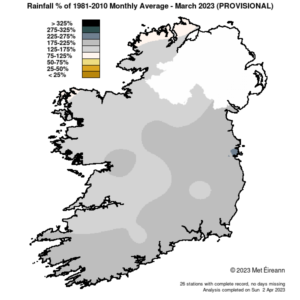
Rainfall % of 1981 – 2010 Monthly Average for March 2023 (Provisional)
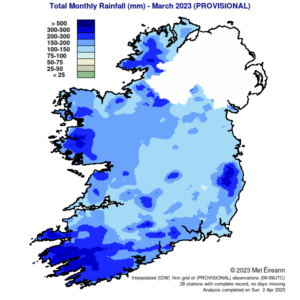
Total Monthly Rainfall (mm) for March 2023 (Provisional)
Temperature: Above average in most places after a cool start
Nearly all mean air temperatures were above their LTA for the month. Deviations from mean air temperature for the month ranged from -0.3 °C (6.6 °C mean temperature) at Markree, Co Sligo to 1.1 °C (7.7 °C mean temperature) at Phoenix Park, Co Dublin. Mean temperatures for the month ranged from 6.0 °C (0.3 °C above its LTA) at Knock Airport, Co Mayo to 8.4 °C (0.1 °C below its LTA) at Sherkin Island, Co Cork. The month’s highest temperature was reported at Phoenix Park, Co Dublin on Wednesday 29th with a temperature of 17.1 °C. The month’s lowest air minimum was recorded on Monday 27th at Dublin Airport, Co Dublin with -4.3 °C while the lowest grass minimum was -11.1 °C reported at Markree, Co Sligo on Wednesday 8th. All stations reported ground frost during the month. The number of days with ground frost ranged from 3 days at Sherkin Island, Co Cork to 16 days at a few stations. More than half of stations reported air frost. The number of days with air frost ranged from zero days at Mace Head, Co Galway to 8 days at both Markree, Co Sligo and Finner, Co Donegal.
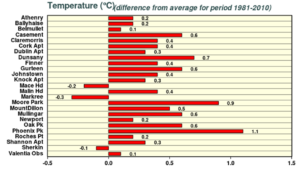
March 2023 temperature difference from the 1981-2010 LTA at synoptic stations
Sunshine: Dull overall, sunniest in the Northwest
All available monthly sunshine totals were below their LTA. Percentage of monthly sunshine values ranged from 75% (monthly sunshine total of 75.3 hours) at Shannon Airport, Co Clare to 95% (monthly sunshine total of 96.6 hours) at Casement Aerodrome, Co Dublin. Monthly sunshine totals ranged from 46.7 hours (No LTA comparison*) at Cork Airport, Co Cork to 105.5 hours (no LTA comparison*) at Belmullet, Co Mayo. The highest number of daily sunshine hours recorded this month was 10.3 hours at Belmullet, Co Mayo on Sunday 26th. The number of dull days ranged from 6 days at Malin Head, Co Donegal to 14 days at both Johnstown Castle, Co Wexford and Cork Airport, Co Cork.
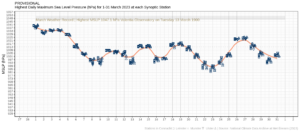
Highest daily mean sea level pressure (MSLP) observed at all available stations for March 2023
Wind: Gales reported
Monthly mean wind speeds ranged from 6.2 knots (11.5 km/h) at Ballyhaise, Co Cavan to 14.7 knots (27.2 km/h) at Sherkin Island, Co Cork. Gales were reported on seven days during the month. The number of days with gale force winds ranged from zero days at most stations to 3 days at both Mace Head, Co Galway and Roche’s Point, Co Cork. There were no strong gales or storm force winds reported this month. Both the month’s highest gust and 10-minute mean wind speed was reported at Mace Head, Co Galway. The highest gust was on Friday 24th with 56 knots (103 km/h) while the month’s highest 10-minute mean wind speed was 39 knots (72 km/h) on both Wednesday 22nd and Friday 24th.
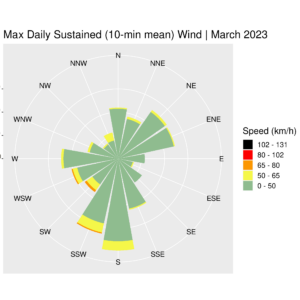
Wind rose for Ireland Max Daily Sustained (10-min mean) March 2023 (provisional)
The full report is available here

March 2023 extreme values at synoptic stations
Recent Marchs in Ireland:
- 2016: The majority of places were below LTA for rainfall and for mean air temperature with monthly sunshine totals below in the East and South and above elsewhere. The strongest winds of the month were associated with Storm Jake on the 2nd.
- 2017: Nearly all rainfall totals were above their LTA. All Mean air temperatures were above, and sunshine totals varied.
- 2018: Very cold with heavy snowfalls, gale force winds and gusts recorded during Storm Emma. Most rainfall totals were below their LTA. All monthly mean temperatures were below average and sunshine totals were variable.
- 2019: All rainfall totals were above average with Storm Freya bringing heavy spells of rain. Nearly all mean air temperatures were above, sunshine was variable, and Storm Gareth brought the windiest spells of the month.
- 2020: The majority rainfall totals were below average. Nearly all mean temperatures were below, sunshine totals were above and Storm Jorge brought the strongest wind gusts on the 1st and the highest recorded March mean sea level pressure (MSLP) of 1051.2 hPa was recorded on the 29th.
- 2021: The majority of rainfall totals were below average, nearly all mean air temperatures were above, and sunshine totals varied.
- 2022: Nearly all rainfall totals were below average while the majority of air temperatures were above and all sunshine totals were above.